A DroneHub at NEST
An aviary for drone research
They maintain and repair buildings, observe natural phenomena and transport goods: Drones and robots could play a major role in our lives in the future. With the DroneHub, a kind of aviary is to be created in the NEST research and innovation building on the Empa campus in Dübendorf, where Empa researchers will explore and further develop the interaction of drones, infrastructure and natural habitats together with industrial and academic partners.
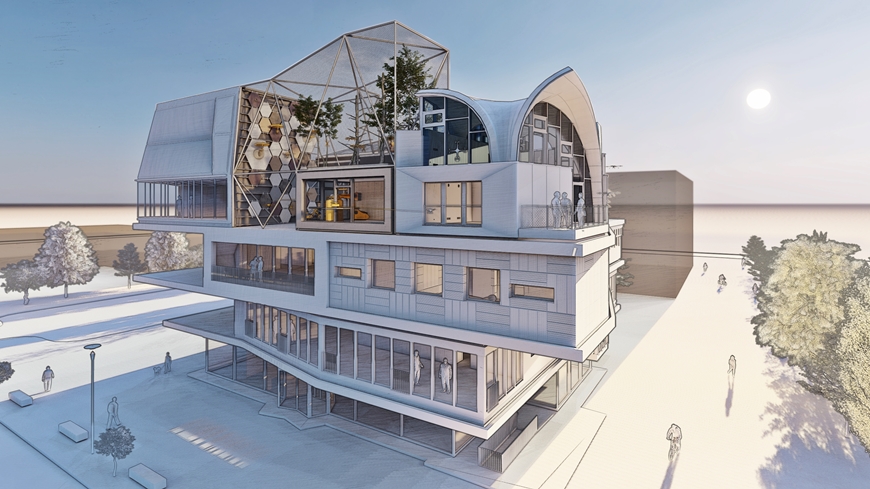
In the same way our immune system protects the human body, drones will in future maintain our buildings and infrastructure. They will detect damage and carry out repair and maintenance work on their own. This is how drone researcher Mirko Kovac paints the picture when he talks about his vision for the interaction between autonomous flying robots and our built environment. The comparison with biology and the human body is no coincidence: As head of Empa's Sustainability Robotics Lab and director of the Aerial Robotics Lab at Imperial College London, Kovac and his team draw inspiration from nature for their research. This results in drones that dive in and out of the water like waterfowl and take to the skies in seconds, or drones that attach themselves to walls and ceilings and rappel down thin threads like spiders. Or entire swarms of drones are being created, inspired by a colony of bees, that can build in a division of labor while flying and with 3D printing processes. At the same time, researchers are working on bio-hybrid flying robots that biodegrade in nature after their work is done, leaving no traces behind.
Such and other drone systems are developed and tested today in the flight arenas at Empa in Dübendorf and at Imperial College London. To complement this and to make the development conditions even more realistic, an aviary is now to be built on the NEST research and innovation building that can be used as a permanent outdoor test environment for various applications. "With the DroneHub at NEST, we also want to better understand the needs of industry in particular and incorporate them into our research," explains Kovac, and therefore explicitly invites interested companies to collaborate.
3D printing on the fly
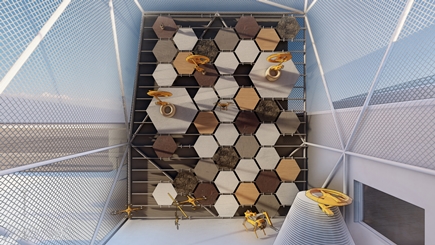
The DroneHub is a kind of cage with a height of up to 11 meters and an area of 90 square meters. It consists of a tube construction and a mesh and will be located on the top platform of NEST – between the two existing units DFAB HOUSE and HiLo. When completed, the DroneHub will provide test environments for three research fields: On the north side, an experimental facade dominates the picture. The wall is fitted with interchangeable elements with different surfaces and is used to develop drones that can carry out inspection and repair work in the vertical. This includes aerial 3D printing processes – in technical jargon, aerial additive manufacturing. "The drones can detect and repair cracks, for example, without the need for elaborate scaffolding or endangering the safety of people," Kovac says.
Having drones on standby at all times increases the speed, at which damage can be repaired – minimizing potential infrastructure outages. "This can be very relevant, especially for energy facilities such as wind turbines or dams," says the drone expert. The fact that the DroneHub is an open air facility, but at the same time embedded in a building structure, means that realistic conditions prevail with regard to wind and weather and the resulting turbulences.
A biosphere for environmental sensing
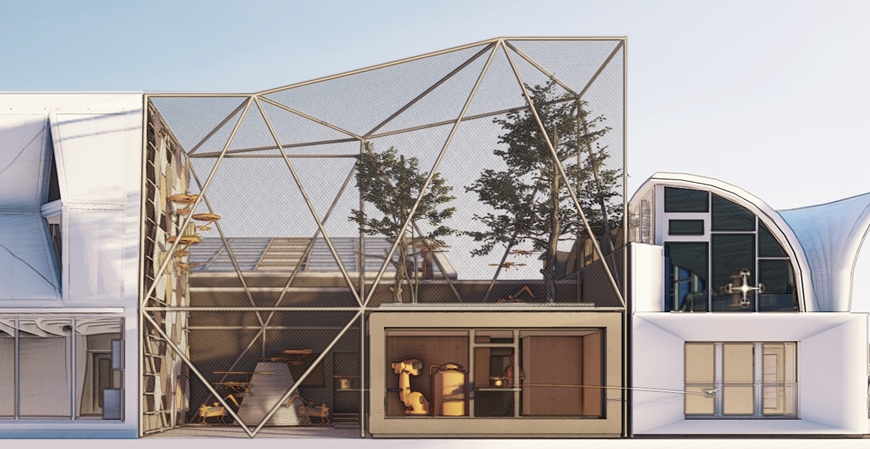
The second research field focuses on the interaction between drones and nature. Today's climate research relies on sensor and monitoring data from the environment. "Drones are perfect data providers – especially in impassable and wide-ranging areas. They can place targeted sensors in nature and read the data with regular flights," explains Mirko Kovac. The important thing is that the sensor and drone systems themselves have no adverse impact on the environment. And that is precisely what the DroneHub is all about: In a naturally designed environment with trees and forest floor, tests can be carried out with biodegradable drone and sensor materials. Part of this biosphere will also serve as a greenhouse for bio-hybrid robot structures – for example, for components for drones made of renewable and biodegradable materials.
Rules for a coexistence of man and machine
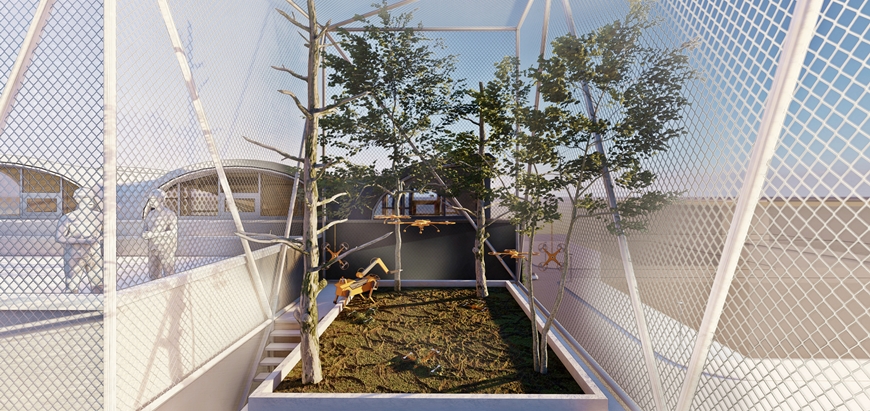
For the third research area, the DroneHub is to be supplemented with interfaces to the outside world. "If we imagine a future, in which drones are naturally integrated into everyday urban life and robots and humans coexist, then we need rules and technological standards for this," explains Kovac. This starts, for example, with the landing sites on or near buildings that drones are to approach autonomously – or with charging stations, at which transport drones independently refuel energy for the next flight. In the DroneHub, the researchers will develop and establish technical guidelines for such interfaces between buildings and flying robots – and help to ensure that a coexistence of man and machine does not remain science fiction.
Greater Zurich area assumes leading role in drone research
A drone for every occasion
Empa researchers are developing drones for all aspects of the environment, represented as the four "elements" of fire, water, earth and air. Illustration: Empa
Prof. Dr. Mirko Kovac
Laboratory of Sustainability Robotics
Phone +41 58 765 4689
mirko.kovac@empa.ch
Stephan Kälin
Communications
Phone +41 58 765 4993
redaktion@empa.ch
More information can be found at: https://nest.empa.ch/drone-hub
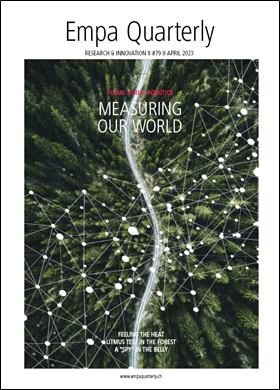
Empa Quarterly#79 Aerial robotics
They fly through fire, sneak past birds, and collect data from the heart of rainforests without leaving a trace: In the current issue, we feature drones with unusual capabilities. In the planned "DroneHub," researchers want to develop and test even more versatile flying robots. And for those who prefer to keep their feet firmly on the ground, the issue also features research projects on quantum technology, medicine, building materials and green electronics.
Read the EmpaQuarterly online or download the pdf-version.
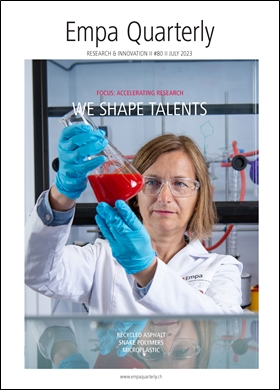
Empa Quarterly#80 Accelerating research
The young people of today are the decision-makers of tomorrow. In this issue, the focus is therefore not (only) on materials and technologies, but also on the people who make them possible: Researchers, founders, apprentices and students. Through support at all professional and academic levels, these talents can reach new heights in science or enter the Swiss economy as urgently needed skilled workers.
Read the latest EmpaQuarterly online or download the pdf-version.
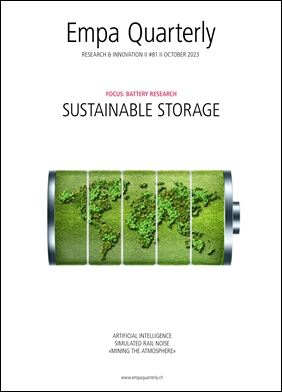
Empa Quarterly#81 Battery research
Being able to store energy is a central pillar of a sustainable energy system, since solar and wind energy are not always available in sufficient quantities when they are needed. Good batteries are indispensable for the energy transition, and thus for a more sustainable world. Empa researchers are developing batteries for different applications, from stationary energy storage to electromobility. They are also working on analyzing and recycling end-of-life batteries.
Read the latest EmpaQuarterly online or download the pdf-version.
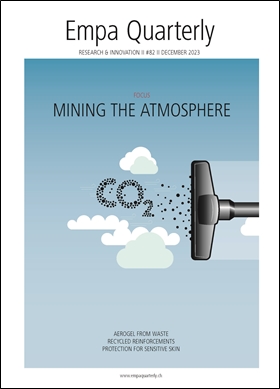
Empa Quarterly#82 Mining the Atmosphere
To limit climate change, we need to compensate not only for future emissions, but also for historical ones. One solution would be the "atmospheric vacuum cleaner": we remove the excess CO2 from the atmosphere. But what do we do with it? Instead of extracting the carbon for polymers, medicines, fibers, fuels and the like from crude oil, we use atmospheric CO2. This is the simple – yet extremely challenging in technical terms – idea behind Empa's new research initiative, Mining the Atmosphere.
Read the EmpaQuarterly online or download the pdf-version.
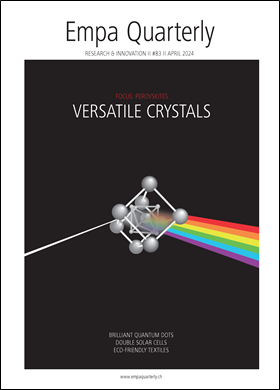
Empa Quarterly#83 Perovskites: Versatile cristals
Over 180 years ago, a curious crystal was discovered in the Ural Mountains. Today, it has given rise to an entire class of materials that is of great interest to researchers: perovskites. What all perovskites have in common is their crystal structure, which gives them unusual properties. By changing the exact composition of the perovskite, scientists can control these properties. Empa researchers are using this promising material to develop solar cells, detectors and quantum dots.
Read the EmpaQuarterly online or download the pdf-version.
-
Share

|
Let there be light |
|
An Empa team has developed a glass brick with good insulation properties thanks to aerogel, which can even be used for load-bearing elements. This makes it possible to build aesthetic, translucent walls that reduce the need for artificial lighting inside the building. |
|
I am sailing |
|
The SailMAV drone can fly and sail on water due to its foldable wings. Its special design also allows it to record wildlife behavior, as animals do not perceive the drone as a hostile intruder. |









